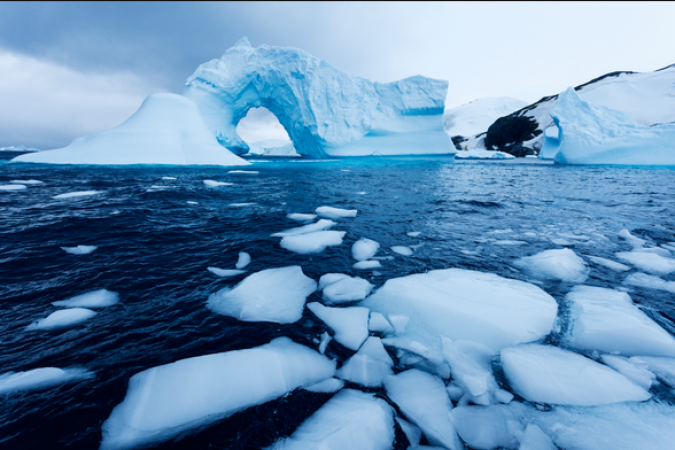
Norway: Ice cubes float in milky blue water. Flowing clouds cover the peaks of fearful mountains. As you get closer to the surface, the sound of the roar of water and the "crack" of snow falling from the arm of Europe's largest glacier intensifies.
The surroundings are vast, natural, and appear to be much larger than humans. It seems as if the whole world is spread before you. The plane carrying the man chasing the glaciers appears almost toy-like against this vast backdrop.
The man is amazed that "there is nobody." "Almost no air is present." Garrett Fischer's playground and, as you soon realize, his life's work, are here.
Also Read: Six months after a deadly earthquake Afghan survivors received new homes
Sitting in the cockpit of his tiny blue-and-white "Super Cub" plane, he is gazing at the globe from a great height. Here, he combines his two lifelong interests in flying and photography in an effort to photograph every still-moving glacier on the planet.
On a fundamental level, Fischer, 41, does it because "I love them." However, he also does it for more important reasons. Because the glaciers on the planet are melting and the climate clock is ticking. Fischer is convinced that there is a reason for all of this to be recorded, saved and remembered.
Because nothing – not even old glaciers – lasts forever. Glaciers change over time. They are getting smaller in a warming world.
According to Fischer, most of them "will be gone or severely reduced in 100 or 200 years". This is the first sign that something is going away and is on the front lines of climate change.
The Alps, for example, have lost about half of their volume since 1900, with the 1980s seeing the most pronounced acceleration of melting, according to data from the European Environment Agency. In addition, glacier retreat is projected in the future.
According to EEA projections, under a moderate scenario, the volume of European glaciers will continue to decline by 22% to 84% by the year 2100. More aggressive modeling predicts losses of up to 89%.
"We have a record of observations of small glaciers in populated areas, especially in the Alps, Norway and New Zealand," according to Roderick van de Waal, a glacier expert at Utrecht University in the Netherlands. According to that record, the glaciers are retreating even more. This is the result of climate change.
Of course, the slow melting of glaciers is an issue that goes beyond aesthetics or even the glaciers themselves. Glacier melting is largely responsible for about 15 cm of sea level rise over the last century.
Also Read: Dutch leader issues apology for nation's involvement in slave trade
Which starts the clock ticking. This resulted in Garrett Fischer moving on. To do so much for so many people, it started for Fischer when he was a young child.
He was raised in a peaceful rural area of New York as the son of local business owners and the grandson of a determined pilot, which exposed him to flying at an early age. He lived close to a private airport.
Fisher's grandfather, Gordon, carried her in the back of his plane when she was just a young child. Although the boy was not happy with this, his despair soon gave way to happiness. He got addicted to flying from the age of 4.
Fischer recalls spending countless hours waiting at the barn door of his grandfather's airplane hangar, while looking out his bedroom window. "You can do anything you set your mind to," the old man would tell him.
Fischer heard from a friend in the late 1990s that glaciers were melting around the world. Since then, it's continued to bother him, to the point where he's added a third element to the triangle: the pressure to finish quickly.
Indescribably beautiful pieces of the world, which he saw as in danger of disappearing, inspired him to preserve them, even if only in pixels.
He claims, "When I'm up, I see these taboo thoughts. They're thoughts that you can't hold in reality and that aren't really shared by anyone else."
He tries to keep the future in mind. He thinks that any records he can capture of the glaciers before they disappear will be invaluable to subsequent generations. Therefore, he founded a non-profit Glacier Initiative to promote and support his work, and he intends to make some of his collection available for public research and the remainder after he passes.
Fischer is not the first person to perceive archival trends in relation to glaciers. Since the development of photography in the first half of the 19th century, scientists and casual observers alike have been fascinated by glaciers.
Knud Knudsen, a leading Norwegian fine art photographer, pursued the landscape with Fischer's passion. He photographed the natural landscape along the west coast of Norway, including fjords, mountains, waterfalls and glaciers.
Knudsen, on the other hand, was earthbound and travelled by boats and waggons in an era when everything related to photography was cumbersome, awkward, and slow.
He carried about 175 pounds of equipment, including glass negatives, on one trip. He could not fly like Fisher could, and he was unable to convey the sensation of looking down.
Norway is only the most recent glacier frontier for Fisher. Before turning his attention to the Alps and Europe, he spent years photographing them in other locations, such as the American West. He has captured thousands of glaciers on camera and still wants more.
Also Read: '3 months- 3 waves...', 70% of Beijing's population infected with Corona
Fisher never loses the sense that he is recording the "decisive moment"—the turning points of a glacier that is still present but in the process of dissipating—even amid the stillness and beauty of his flights. With each flight, he is aware that he is watching a slow-moving tragedy play out in front of his eyes.